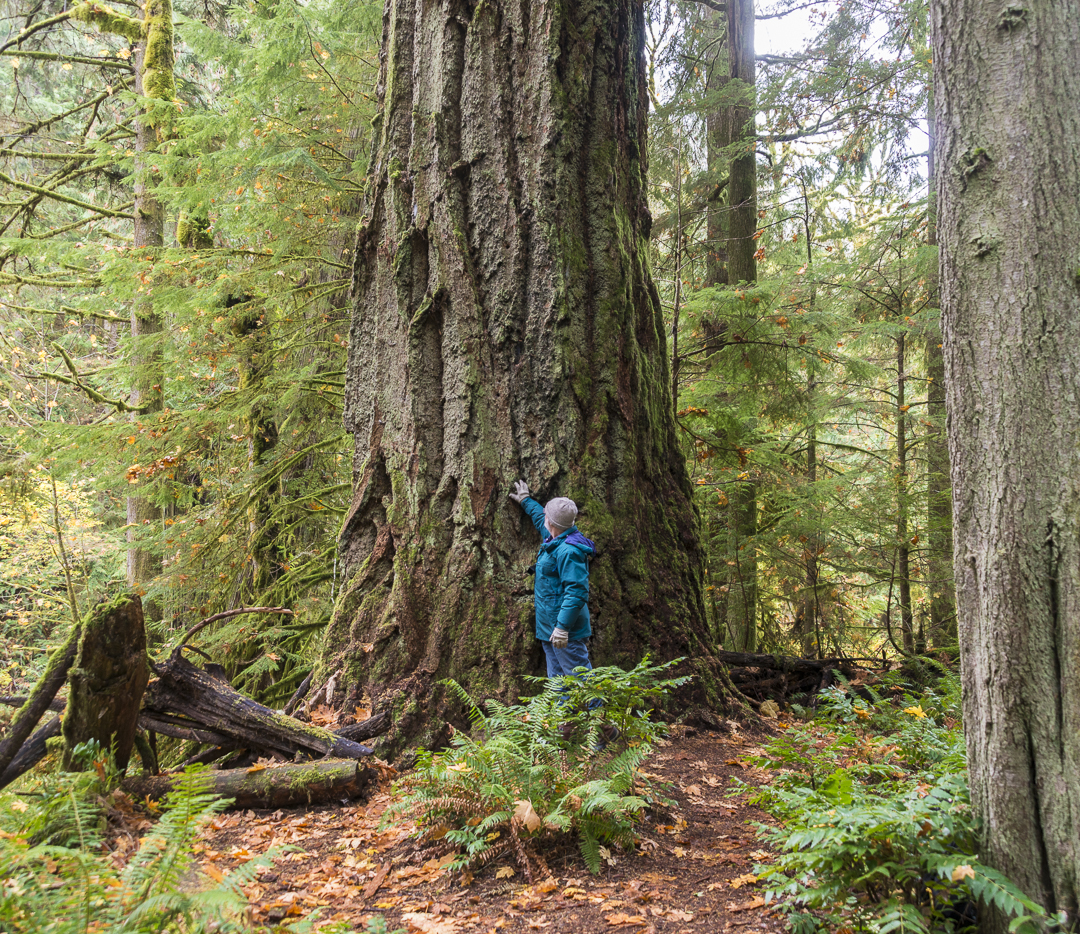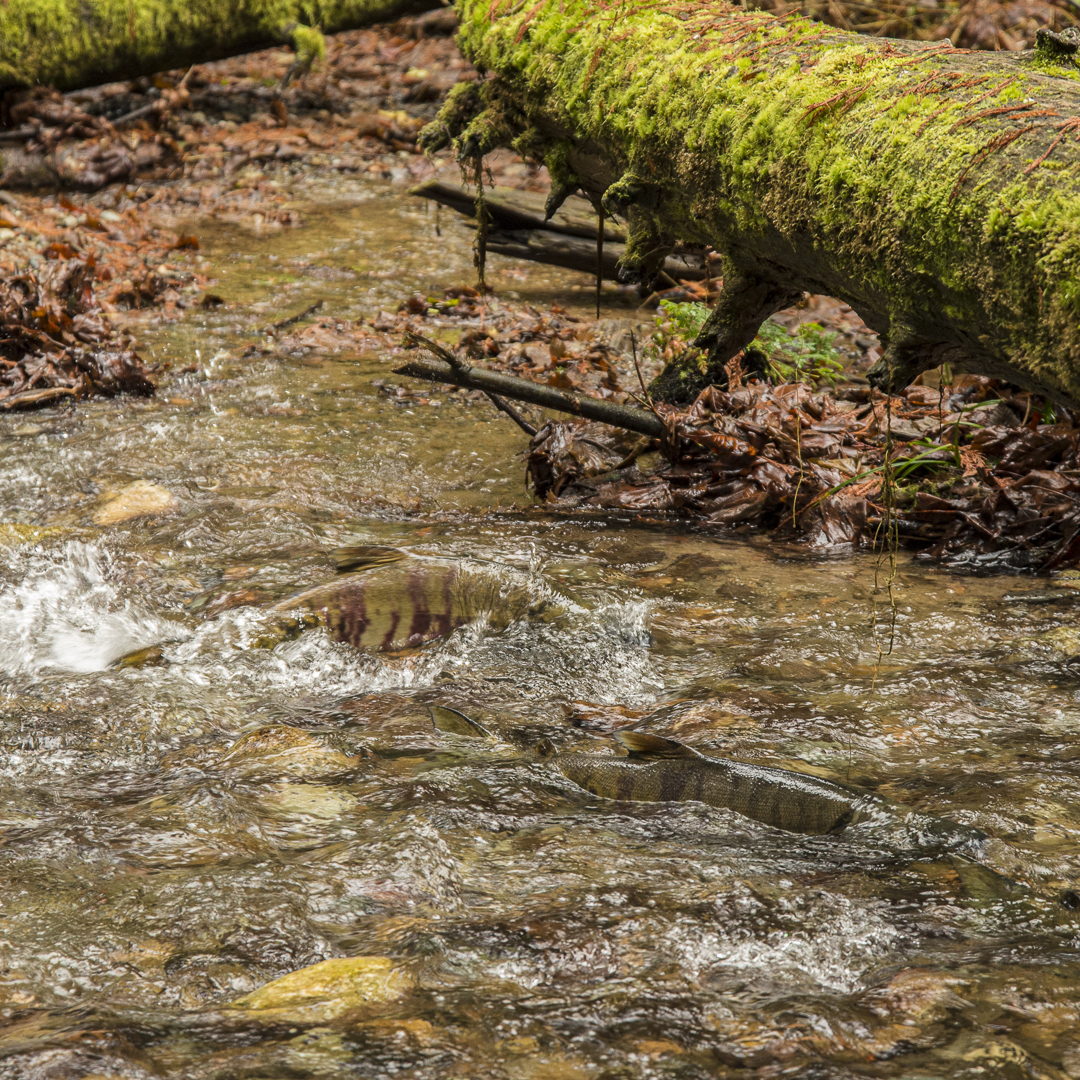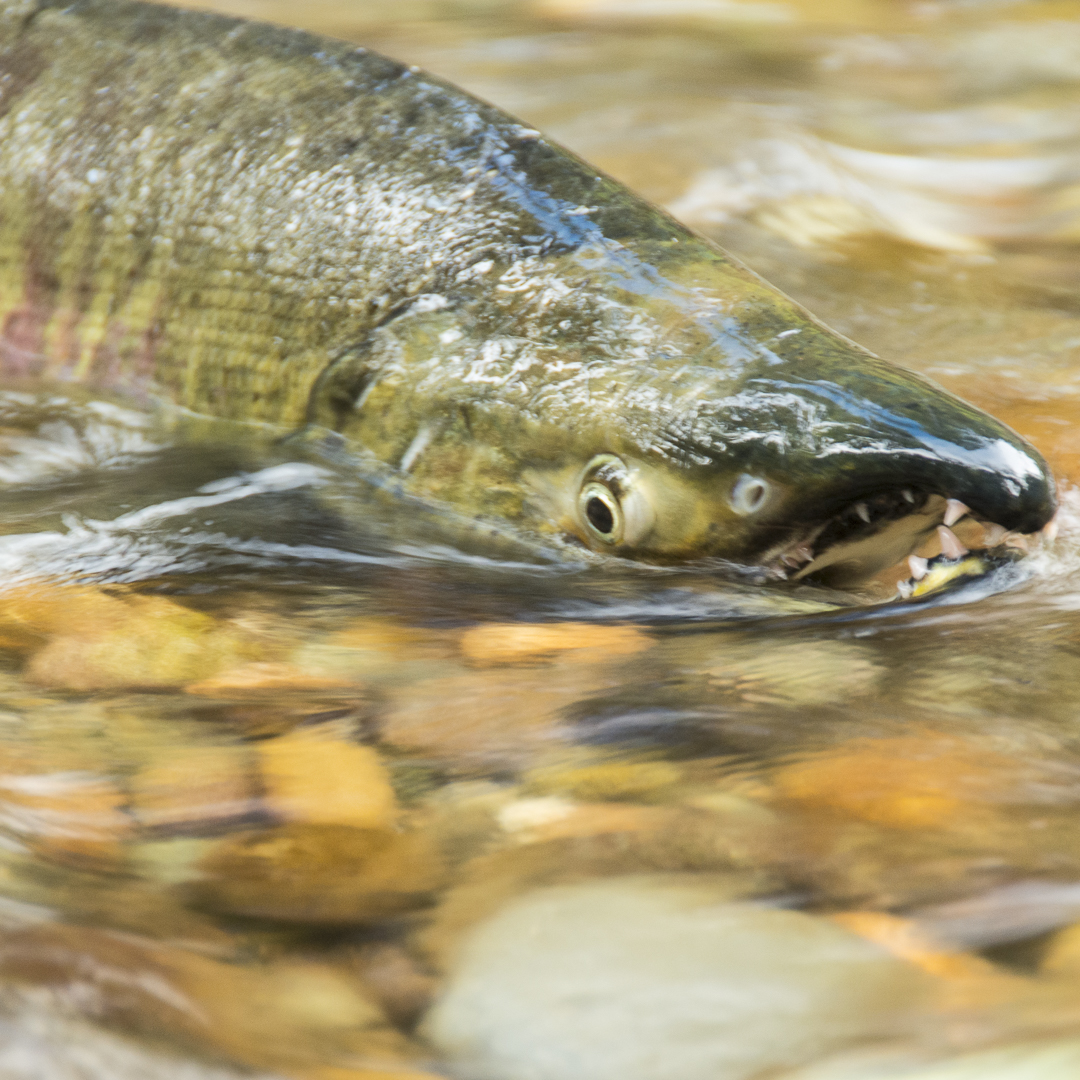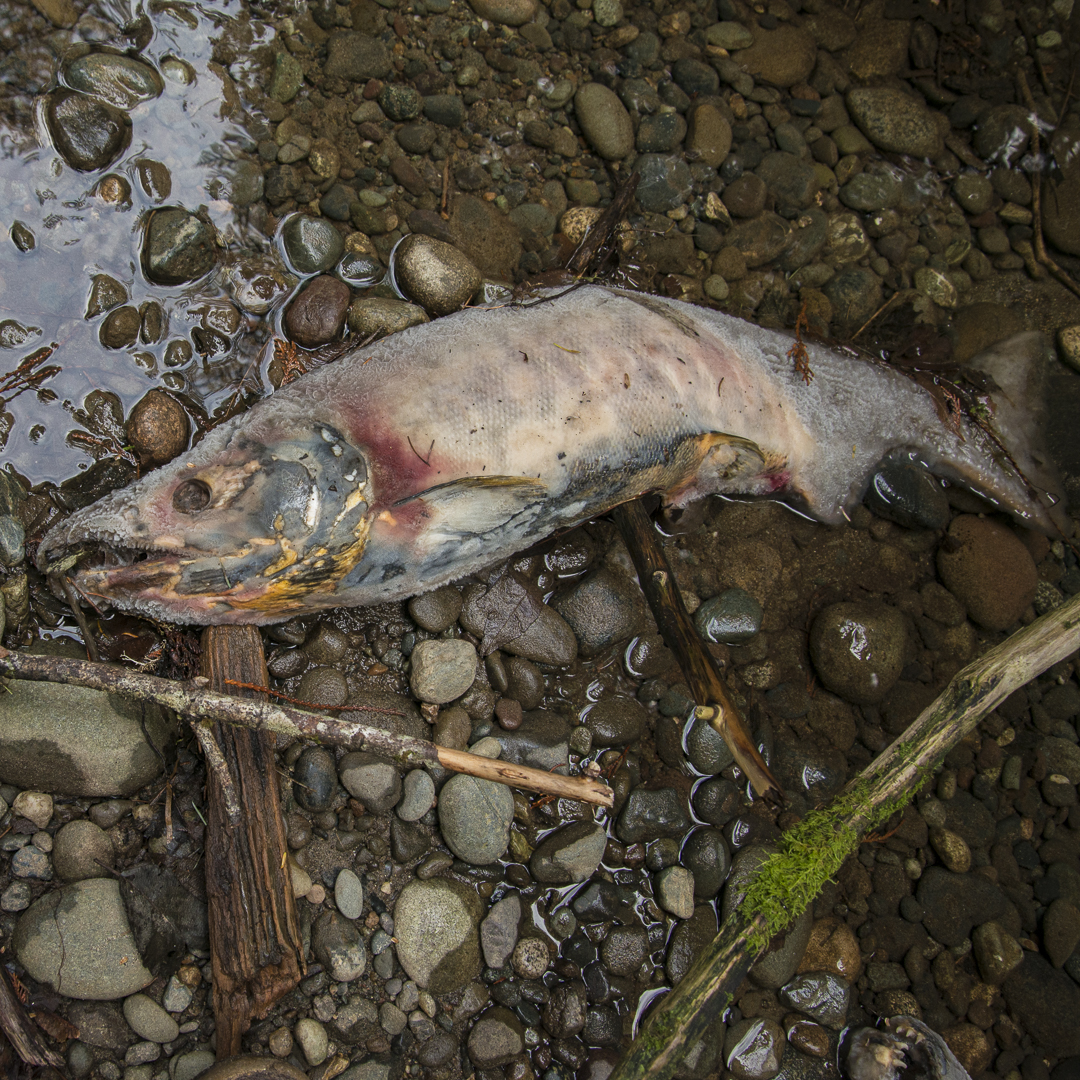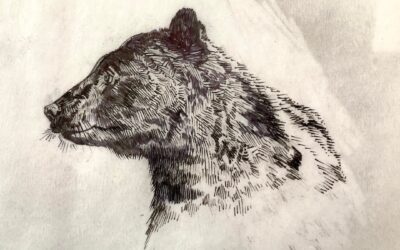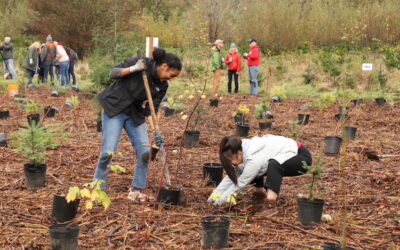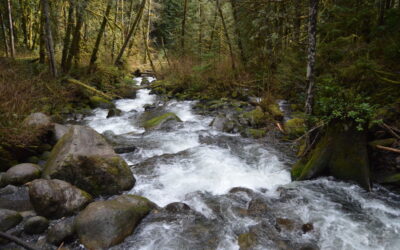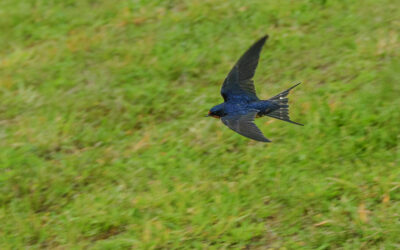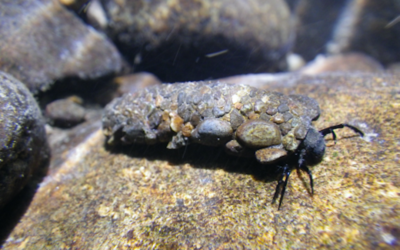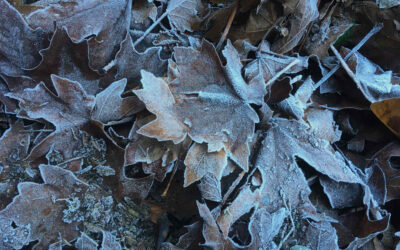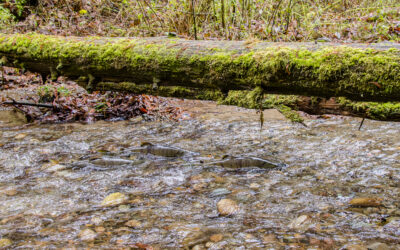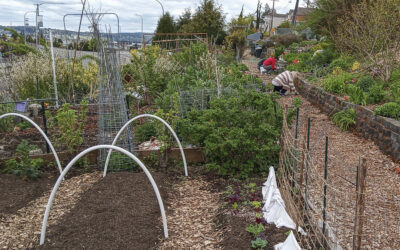MANY CYCLES OF NATURE
by Leigh Calvez, Winter 2020
Photos by John F. Williams except as noted
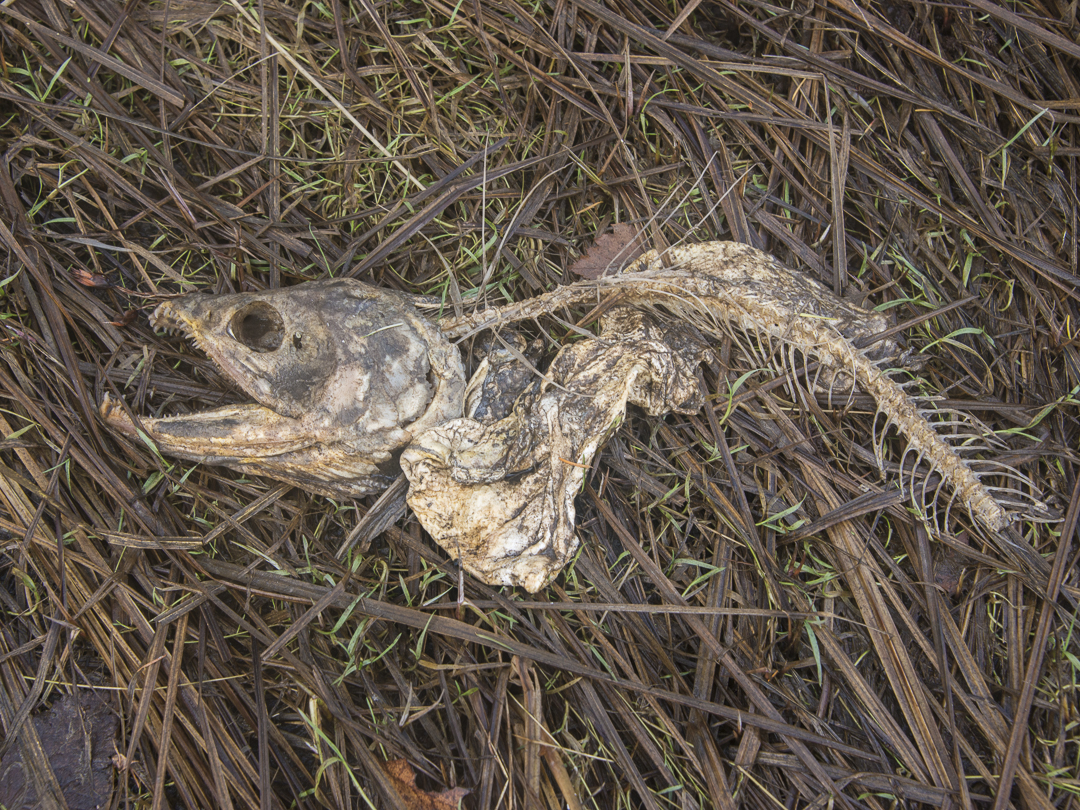
MANY CYCLES OF NATURE
by Leigh Calvez, Winter 2020
Photos by John F. Williams except as noted
As children we come into a world filled with the cycles of nature. We watch with wonder as the first crocuses of spring poke tiny, green heads through muddy soil, then burst forth into bright purple and white blooms. We enjoy the warm breezes of long summer days. As days begin to grow short, we marvel as the leaves turn from green to bright reds and oranges before falling to the ground. We dress in our warm winter clothes and play outside as the first flurries drift in on a cold wind. The change of seasons is one of the most obvious cycles of nature, its rhythm carried deep in our bones.
Yet, for most of us, we live our daily lives thinking linearly with the habit of the western mind. As the days and weeks turn to months and years we think of time passing, moving toward us in a straight line from future to present to past as if we were driving a car through the moments of our lives. But in the last twenty-five years or so, science has offered us many new views of nature from a cyclical perspective. The nature all around us flows from one phenomenon to the next, affecting everything.
For me, one of the first and strongest images of these newly discovered natural cycles came to me as I was reading a study about traces of salmon DNA found in the trees in the old growth forests of the Pacific Northwest. I was startled. How could bits of salmon be found within the very tissue of the long fronds of cedar or the tallest firs high up on the mountains?
In the wilderness of British Columbia’s Great Bear Rainforest, where this scientific discovery was made, salmon gather close to shore, eager to spawn. As they await the annual autumn rains to fill the winding rivers and streams they will travel, tails move whole bodies from left to right with the rhythm.
 See more about the importance of salmon to the forest in this BBC video.
See more about the importance of salmon to the forest in this BBC video.
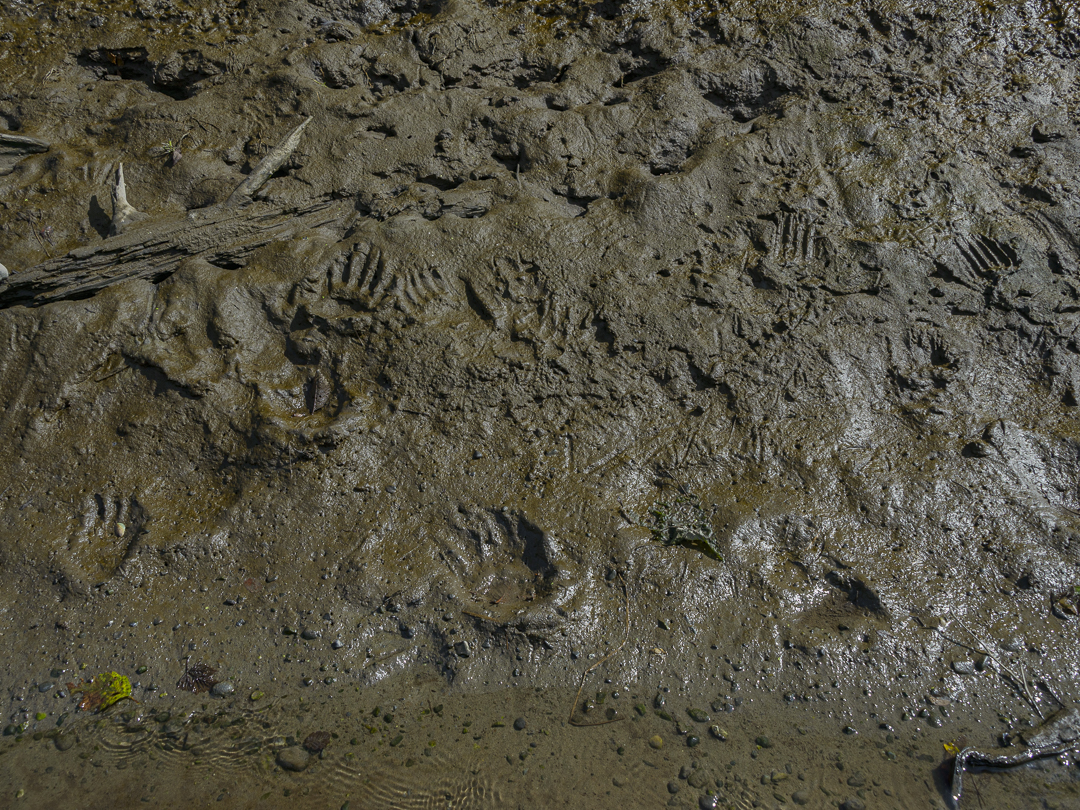
Tracks from birds and bears at the edge of Grovers Creek, Kitsap.
Brown and black bears, and coastal wolves, hoping to fatten up for the winter, wait too, hoping to catch the salmon midstream, as they swim upstream to the place of their birth. Often these mammals carry the remains of their freshly caught meals into the forest, dropping the salmon at the base of trees, as fish parts or as bear and wolf droppings.
As the salmon remains decay, their DNA decomposes too, breaking down into smaller compounds that are absorbed into the environment as nutrients for forest plants.
These nutrients include a specific isotope of nitrogen found in salmon but not otherwise found in forests. It’s this nitrogen that the salmon brought from the ocean that fertilizes the forests and is found in the trees.
The return of the salmon has long been enjoyed each year by animals and people alike. It is an annual celebration passed down to us by the Native American tribes who call the Salish Sea home.
The five salmon species of the Pacific Northwest — Chinook or King salmon, Coho or Silver salmon, Chum or Dog salmon, Pink or Humpy salmon, and Sockeye or Red salmon — follow the cycles laid down across millennia by their ancestors, returning to rivers from British Columbia to California to spawn the next generation.
We can witness these magnificent cycles for ourselves around the Northwest in places like Fish Creek in Poulsbo, Jarstad Park in Bremerton, Chico Creek in Silverdale, the Ballard Locks Fish Ladder near Seattle, the Issaquah Hatchery, and many other salmon streams in the Salish Sea region.
Orcas in British Columbia, photo by Frank Busch, Unsplash.
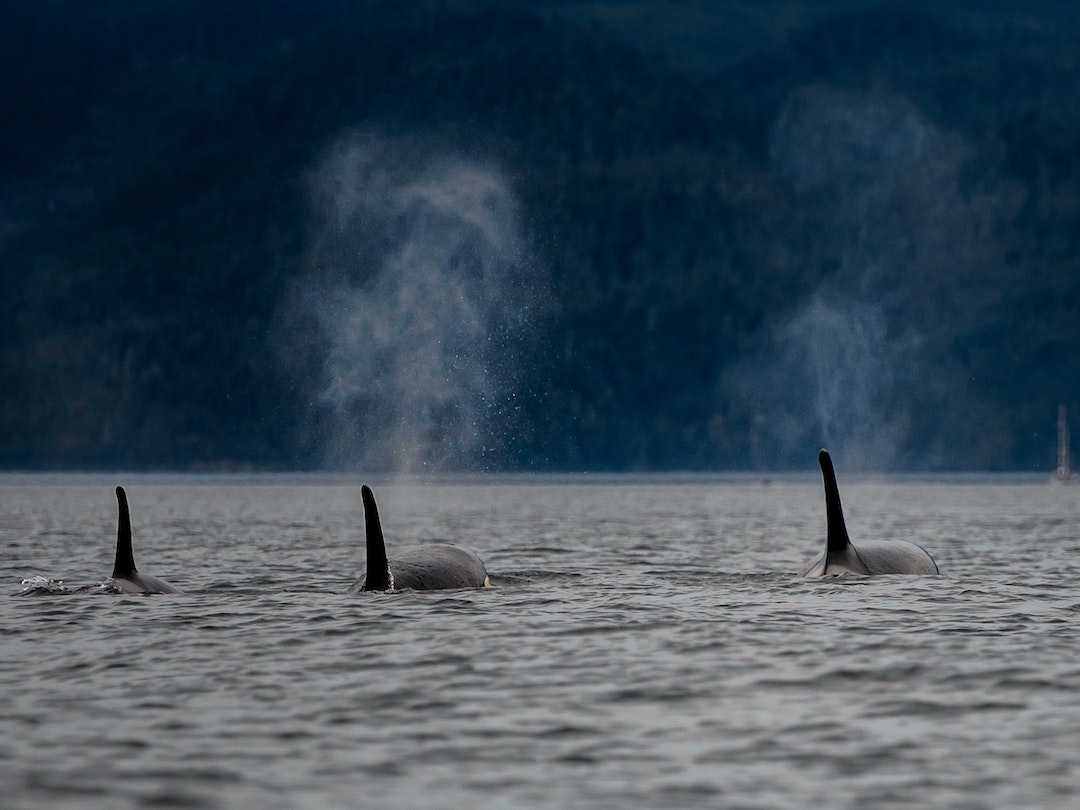
Orcas in British Columbia, photo by Frank Busch, Unsplash.
And there is another way we can occasionally witness the salmon cycle indirectly. For many centuries the Southern Resident Orcas — pods J, K and L — have staked their lives on these annual migrations. They followed the daily rise and fall of the tides along the west side of San Juan Island from June through September to chase runs of King salmon swimming from the Pacific to the mouth of the Fraser River in British Columbia. Now those runs have dwindled to less than life-sustaining and the Southern Residents must travel elsewhere for food, now visiting our inland sea infrequently.
Visit the Orca Network web site for recent sightings information. For more detailed information about the resident orcas of the Salish Sea, read The Breath of a Whale by Leigh Calvez.
Yet others, like the bald eagles and California and Steller sea lions, depend on the annual return of the salmon, just as the lacy cedars and the towering firs do.
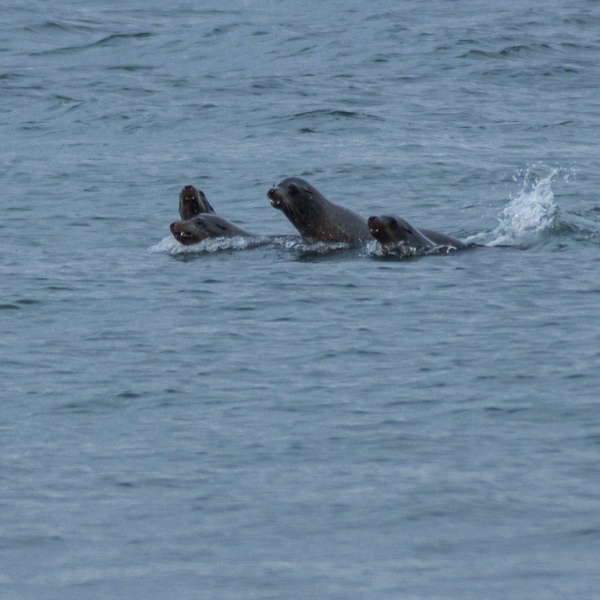
Sea lions off Point No Point, a salmon transit area also well known to human fishers.
As we stand along the streams watching these salmon returning to spawn, we may notice gills fluttering in the cyclic intake of oxygen that even fish experience. We may notice leaves falling from the trees around us.
What we may not notice is the nutrients from those trees, in the form of rotting leaves—the simultaneous end and beginning of a cycle—washing into small rivulets that run into streams, that run into the Salish Sea. These are providing essential nutrients for plankton that feed small fish like herring that feed the small salmon that will one day feed the orcas, bears and wolves that will in turn feed the trees. We rely on these very same trees, which may not exist at all without essential nutrients brought by salmon, to produce the oxygen we all need to breathe in the grand dance between carbon dioxide and oxygen molecules.
Video by Paul Dorn
Recently with the help of satellite technology we have been able to witness another annual cycle. In the spring, when the northern hemisphere is tipped toward the sun, trees green as leaves begin to grow, absorbing carbon dioxide for photosynthesis from the atmosphere—the annual in-breath of trees. As the planet moves around the sun and the northern hemisphere is tipped away, receiving less warmth from the sun, we move into the cooler months of the year, leaves fall and carbon dioxide levels increase. It’s as if our beautiful earth has released her breath.
Life is never static. It is ever-changing.
Our life-sustaining, blue jewel of an earth travels through space, carrying us through the years, as a mother possum carries her babies clinging to her back.
Our earth spins once a day on her axis, as we breathe the sweet oxygen given to us by trees. We watch our children play beside streams that support the lives of salmon that nourish orcas and bears and trees. We live our lives each day surrounded by mysteries yet unimaginable.
What are the larger cycles we have yet to understand? What will we learn about how these cycles impact planet Earth and our corner of the world in the Pacific Northwest’s Salish Sea?
We are sustained by the natural cycles within cycles of planet Earth, many of them still mostly unknown or unnoticed. What cycles will you notice today?
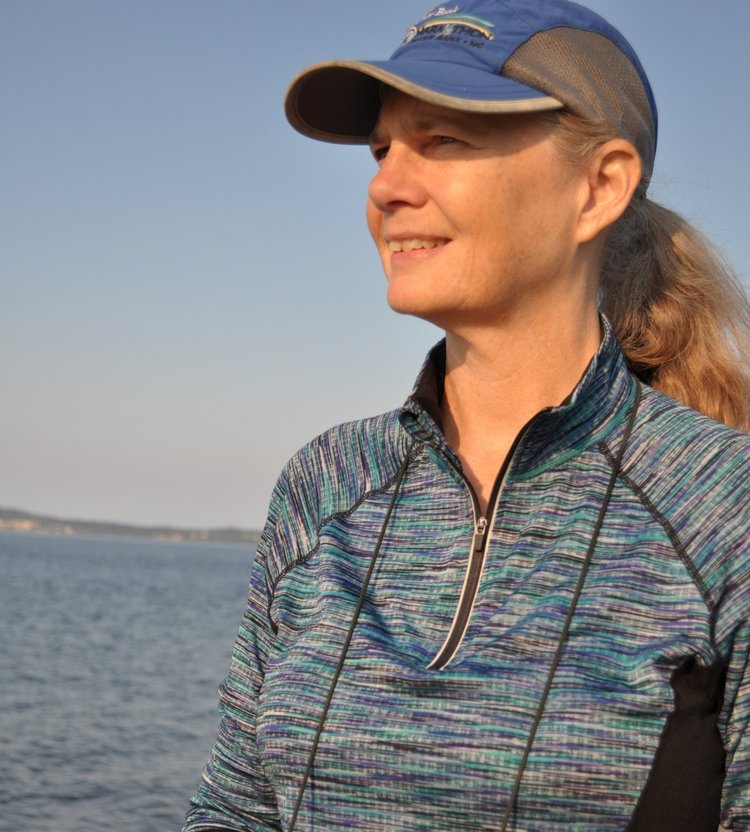
Leigh Calvez is a naturalist and nature writer. She studied humpback whales in Massachusetts and on Maui, Hawaii along with spinner dolphins on the Big Island of Hawaii. As a naturalist, she has led whale watching tours around the world to places like the Azores, New Zealand and British Columbia. Her interest in the natural world led her to nature writing and her first book “The Hidden Lives of Owls: The Science and Spirit of Nature’s Most Elusive Birds.” Leigh’s essay about her adventures in the Great Bear Rainforest in British Columbia was published in “American Nature Writing 2003” by Fulcrum Books. Her work was also published in an anthology for Sierra Club Books entitled “Between Species: Celebrating the Dolphin-Human Bond.” Leigh’s essays have also appeared in Smithsonian Magazine, High Country News, The Ecologist, Ocean Realm, The Christian Science Monitor, The Seattle Times and The Seattle Post-Intelligencer. Her second book, “The Breath of a Whale: The Science and Spirit of Pacific Ocean Giants,” from Sasquatch Books was released in March 2019.
Table of Contents, Issue #10, Winter 2020
Woodland Witness
by Zoe Wadkins Winter 2020 Drawings by Zoe Wadkinsby Zoe Wadkins, Winter 2020 Drawings by Zoe WadkinsIn the three years since our first introduction, I have walked this loop of Deer Creek more than one hundred times. Its rich macroinvertebrate habitat constitutes a...
Restoring Forests
by Dan Hintz, Winter 2020You can see this 2019 Mountains to Sound Greenway tree planting site at Lake Sammamish State Park, located along Issaquah Creek. Photo by Katie Egresi.You can see this 2019 Mountains to Sound Greenway tree planting site at Lake Sammamish State...
Salish Sea and Dinosaur Pee
by Sarah Lorse, Winter 2020 Photo by Sarah Lorseby Sarah Lorse, Winter 2020 Photo by Sarah LorseHow wonderfully wet things are here beside the Salish sea. Whether it is a big fat raindrop dangling off your nose or the impressive volume of a king tide, water is all...
See the Salish Sea by Saddle
by Jessica C. Levine, Winter 2020 Photos by Jessica C. Levineby Jessica C. Levine, Winter 2020 Photos by Jessica C. LevineI spend a considerable amount of time pondering cycles. As a cyclist, I bike year round. I’m also a naturalist and place-based science educator....
Swallow Season
by Donna Bunten, Winter 2020 Photos by Donna Bunten except as notedPhoto by John F. WilliamsPhoto by John F. Williamsby Donna Bunten, Winter 2020 Photos by Donna Bunten except as notedI dread August—the end of summer, sliding farther down the slope towards darkness,...
Sacred Stream Insects
by Gavin Tiemeyer, Winter 2020 Photos courtesy of King County except where notedby Gavin Tiemeyer, Winter 2020 Photos courtesy of King County except where notedLearning about the natural cycles that govern the health of the Salish Sea starts with peering into your...
Issue 10 Poetry
Winter 2020Photo by Adelia RitchiePhoto by Adelia RitchieWinter 2020Water Drop By Mahathi Mangipudi Wide strokes of grey paint the sky On the windward side of the Cascades Air masses from the Pacific Ocean Saturated with water vapor Condense into little...
The Many Lives of Tree
by Pat Kirschbaum, Winter 2020Photo by John F. WilliamsPhoto by John F. Williamsby Pat Kirschbaum, Winter 2020We are so lucky in the Pacific Northwest to have many places to go where we can be surrounded by trees. As I sat alongside a nearby stream recently, I...
Community Gardens
by Alison Ahlgrim, Winter 2020Photo by Michael YatesPhoto by Michael Yatesby Alison Ahlgrim, Winter 2020My first visit to Everett was a reconnaissance mission to see if my husband and I might like to live there. Drawn to the water, we ended up at the waterfront...
PLEASE HELP SUPPORT
SALISH MAGAZINE
DONATE
Salish Magazine contains no advertising and is free. Your donation is one big way you can help us inspire people with stories about things that they can see outdoors in our Salish Sea region.
We also don't advertise Salish Magazine, so please spread the word of this online resource to your friends and colleagues.
Thanks so much for your interest and your support.
We also don't advertise Salish Magazine, so please spread the word of this online resource to your friends and colleagues.
Thanks so much for your interest and your support.

